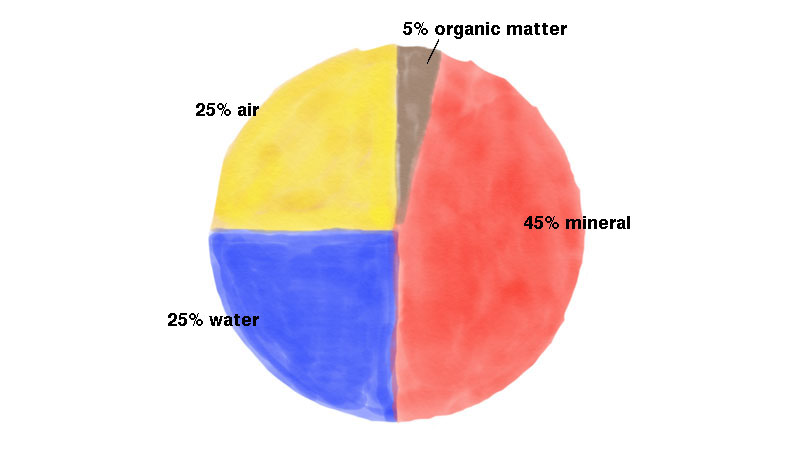
While methods of growing and associated tools, terminology and techniques are important, the foundation of all gardening and growing is the medium in which you grow—the soil. So before we go on to explore permaculture gardening further, let’s roll up our sleeves and dig in the dirt a little bit as we take a closer look at soil
Soil Composition 101
What is soil, exactly?
Well, at its simplest, healthy soil is a combined mix of the various elements that make up our earth, divided into four major components. Technically speaking, soil is:
- 45% minerals
- 25% air
- 25% water
- 5% organic matter

Do you see how 50 percent of good, healthy soil is pore space—open space that holds the air and water? Ironically, this makes the soil rich.
That 25 percent water and 25 percent air is there because of the voids in the soil left by roots and tunneling soil organisms. These ingredients are essential for healthy plant growth and occur in balance with minerals and organic matter in an uncompacted soil that provides porosity for air and water movement and storage.
For most lawns, the process of loosening your site’s soil with a shovel, adding compost (see below) and building a raised bed will drastically improve a soil’s porosity.
For more neglected sites—such as reclaimed areas where topsoil is completely stripped and/or waste material like concrete is apparent—bringing in more, and better-quality, mineral-rich compost is necessary to build up the garden bed.
With time, the biological and chemical actions of the growing edible ecosystem improve soil. This is as true for your yard as it is for a reclaimed urban lot.
Building Your Compost
Now, about that five percent organic matter—biologically active compost is a major source of soil fertility. Organic matter helps the soil store fertility and release it in balanced manner.
But what is compost? Well, it could be made from composted manure, with additional mixes of woody debris or household compost. Getting good compost can be as easy as finding a local compost company and asking for a well-composted, weed-free, fertile compost.
Many composts are low in nitrogen, which is lost in the composting process and then to the atmosphere through aeration. You can add in further organic matter—such as fish, poultry or blood fertilizers—to put that nitrogen back and improve your compost and, by extension, your soil.
Bagged products from stores will work in a pinch. But you do not want a purely organic soil in your garden bed! A good mix will also require some mineral-rich soil to balance the organic matter, improve drainage and enhance soil life habitat.
Especially if you have sandy soil, try to find local clay to mix into your compost. Conversely, if your mineral soil is mainly clay, find some local sand to mix into your compost.
Usually, what you’re looking to achieve is loam—an equal mix of sand, silt and clay with five to 10 percent organic matter. That’s the best soil.
Learn about Permabeds and how you can use them for better growing results.
Good Soil In Your Garden
Okay, you’ve got your organic matter and mixed in sand, silt and/or clay to achieve a nice loam. Now what?
If your compost has weed seeds in it, spread compost before you cover the site with weed barrier. This will both kill weeds in the ground and take care of seeds that may be in farm-fresh compost. Also, the compost will fertilize the soil while the weed seeds are being removed from the soil’s weed seed bank (an account we prefer empty).
You may want one or two wheelbarrows of a mineral-rich compost for a 20-foot garden bed to get going. The more, the merrier, I say, especially if your soil is shallow, with bedrock near the surface, or it has a lot of stones and pebbles.
Stick a shovel into the ground 12 inches. If you don’t hit solid rock, you have enough topsoil. (Stones don’t count.) In this case, one bag of pure organic compost will be sufficient. You can just mix it into the topsoil and subsoil while turning the soil.
In this way, you’ll build up your garden bed by working with your local soil. If necessary, you can bring in more material to make an ideal environment of healthy soil for good plant growth.
Here, it’s helpful to know what your local soil has to offer before any amendments are added. A soil test, available through your local extension agency and some universities, will give you a better understanding of your soil profile.
Do you have lots of mineral soil on site? In this case, you’d mainly need organic matter.
Or maybe your soil is a great mix of mineral loam with seven percent organic matter. In this case, you can just bring in more material to simply help raise the garden bed for better drainage.
Next up, we’ll look at how you can build and maintain an active ecosystem in your healthy soil you’re building.




